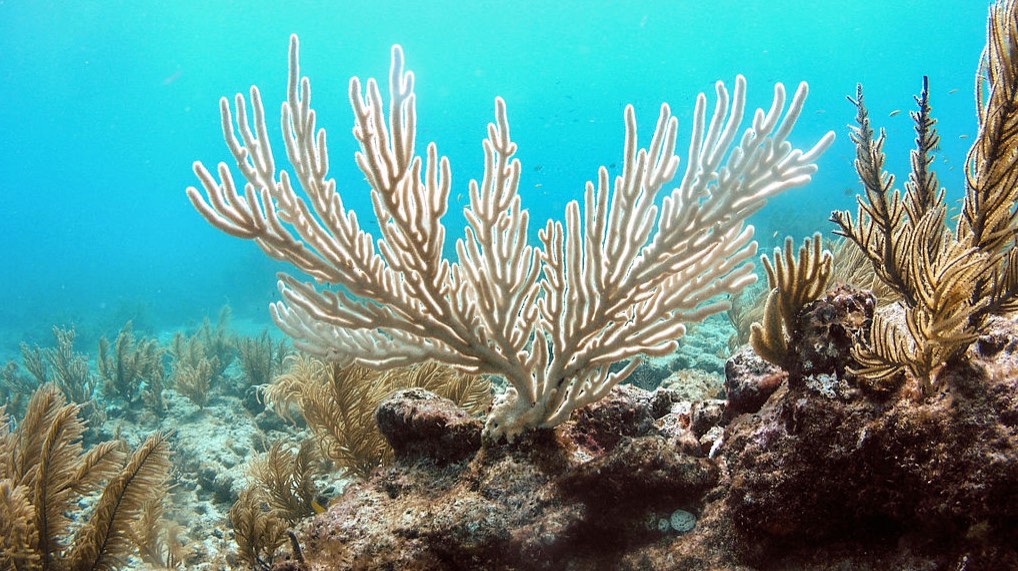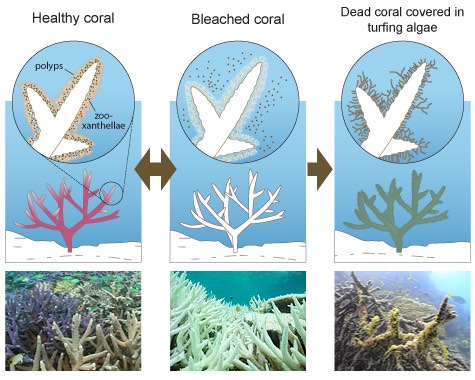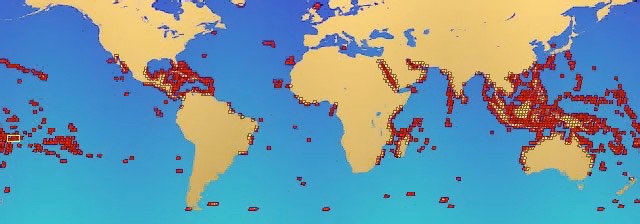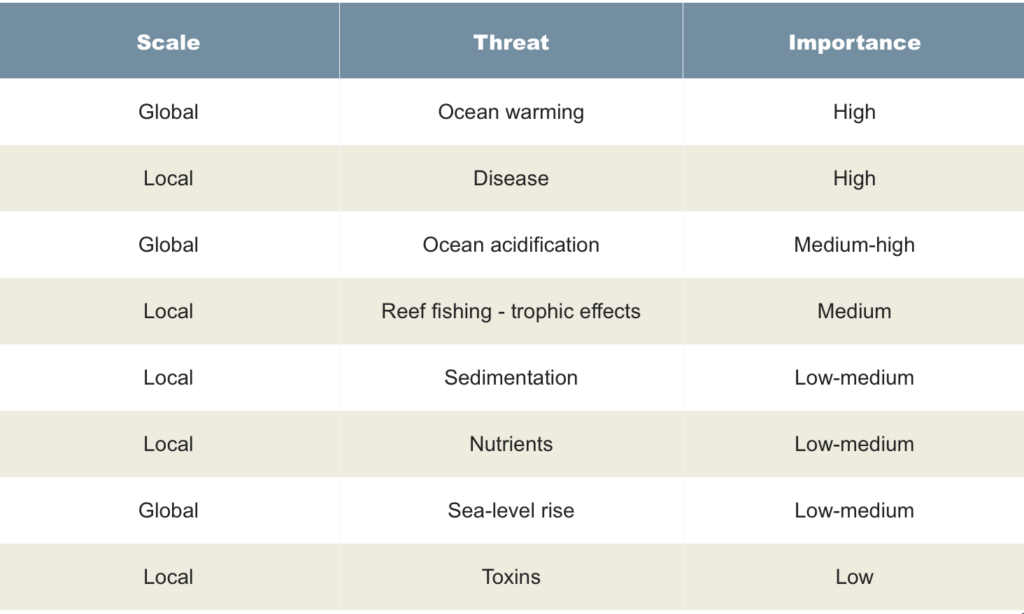Climate Change
1.5 Warming Oceans Cause Coral Reef Bleaching
Brittany L. Sulainis
Coral reefs are important to the survival of many ocean dwelling organisms and the tourism industry of certain coastal regions. Algae and coral reefs share an important relationship. What will happen if this symbiotic relationship is disrupted due to coral bleaching? Will the remaining organisms in this ecosystem survive without living coral?

Photograph by Kelsey Roberts, 2014. CC BY 2.0.
Coral reef communities have helped shape the dominate ecosystems of the oceans for over 200 million years. They contain a collection of biological communities and make up one of the most diverse ecosystems in the world. Coral are classified as cnidarians, and they are sessile aquatic animals that can only catch small prey (fish and planktonic animals) by using their tentacles.1 Individual polyps live in colonies that form coral reefs and are able to retract inside their skeleton for protection when predators approach. The reefs are composed of hard calcium carbonate skeletons that coral secrete over time and the growth rate of these structures depends upon the specific coral species alongside other environmental conditions. Coral reefs are critical to the survival of a large amount of ocean dwelling organisms because they provide a food source and shelter.2
Coral has an important symbiotic relationship with algae. A symbiotic relationship is one that is considered mutually beneficial to both of the organisms involved. Algae lives inside of the coral polyps and produces food through the process of photosynthesis, which it then shares with the coral. This relationship works well since coral reefs are located in water that is shallow and clear, which allows large amounts of sunlight to reach the algae. Sunlight is needed for algae to produce food for both species.3
A phenomenon that has become a large global concern is known as coral bleaching. Coral bleaching occurs when the symbiosis between algae and the coral is disrupted due to the algae being expelled from the polyp. When this occurs, coral loses its color as the white calcium carbonate skeletons of the coral colony are exposed (Figure 1 and 2). Coral reef communities are sensitive to changes within the ecosystem, especially to water quality.4 These communities can only endure a small range of temperatures and other chemical characteristics, thus scientists use coral reefs as indicators for when something may be wrong in the environment. Mass bleaching events are causing large coral mortality, which is endangering the ecosystem.4

Used by permission from the Commonwealth of Australia, Great Barrier Reef Marine Park Authority, 2011. CC BY-ND-NC 2.0.
In 2009, eighty three coral species were petitioned to be listed under the U.S. Endangered Species Act.5 There was great concern that these coral species were going to become functionally extinct, followed quickly by absolute extinction. At the time, eighty two of the eighty three species were given a pending status due to the necessity of proof of their endangerment. In each case, climate and ocean change was cited as the cause of species decline.5 Mass bleaching events have shown a positive correlation with the increase in average seawater temperature. Approximately 25% of the carbon dioxide produced by human activity has been absorbed by the oceans.5 This CO2 absorption creates changes in seawater chemistry called ocean acidification.6 Not only are ocean acidification and rising sea temperature causing corals to bleach, these changes also have negative effects on the developmental stages of larval coral and the adult coral’s ability to reproduce.7 The effects on coral are immediate and if they do not cause mortality, they reduce coral growth and cause several other harmful long term effects.8

Courtesy of NASA, 2006. Public Domain.
Naturally, conservationists find themselves concerned about the loss of coral reefs as coral bleaching continues to increase. Several reefs around the world are immensely degraded and studies have yet to uncover whether they have the ability to regenerate. Scientists fear that coral species will not survive the end of this century.8
The loss of coral reefs assures grim consequences because they attract great amounts of tourists that constitute a large portion of income for coastal areas. The Caribbean has lost nearly 90% of its reefs, which attract up to one hundred million tourists each year. With the loss of its coral reefs, the Caribbean will experience a decrease in revenue from the tourism industry.9 Coral reefs also play a key role in protecting coastlines from flooding, erosion, and storm damage. Without this protection, repair costs would total hundreds of billions of dollars each year.3
In the journal article, Incorporating Climate and Ocean Change into Extinction Risk Assessments for 82 Coral Species, the authors collected and analyzed data to determine whether the most prominent coral species were at risk of extinction.5 The conclusions of the study were derived from analyzing other in-depth studies and looking at predictions of future climate conditions. The Coral Biological Review Team determined that the biggest threats to coral were disease, ocean warming, and ocean acidification. The team then estimated the importance of each threat relative to extinction risk, and ocean warming was ranked as the highest (Figure 4). The team concluded that there was insufficient evidence to show that corals can adapt to this new climate, especially considering the rate ocean temperature is expected to increase over the next century.5 The scientists found that corals do not possess effective adaption mechanisms for these new conditions.5, 10

Modified from Brainard et al., 2005.
The fate of coral reefs is still uncertain. It is nearly impossible to predict what will happen in the long term since the two largest threats to coral extinction are caused by climate change, a science that’s consequences are not fully understood. Human activity is inflicting terrible damage to our planet and it is unknown how long it will take the oceans to return to their prior average temperature once CO2 emissions are reduced. It is also unclear whether coral reef communities can reestablish themselves after ocean temperatures stabilize or if other organisms can fill coral reef’s vital role as a diverse ecosystem.
References
- Brown, B.E. (1997). Coral bleaching: causes and consequences. Coral Reefs, 16:S129-S138.
- U.S. EPA. (2012). Coral Reef Protection: What are Coral Reefs?, EPA.
- Hoegh-Guldbuer, O. (1999). Climate change, coral bleaching, and the future of the world’s coral reefs, Marine Freshwater Research, 50:839-966
- Penin, L., et al. (2013). Response of coral assemblages to thermal stress: are bleaching intensity and spatial patterns consistent between events?, Environmental Monitoring Assessment, 185:5031-5042.
- Brainard, R.E., et al. (2013). Incorporating Climate and Ocean Change into Extinction Risk Assessments for 82 Coral Species, Conservation Biology, 27:1169-1178.
- Fang, J.K.F., et al. (2013). Sponge biomass and bioerosion rates increase under ocean warming acidification, Global Change Biology, 19:3581-3591.
- Rodríguez-Troncoso, A.P., et al. (2013). The effects of an abnormal decrease in temperature on Eastern Pacific reef-building coral Pocillopor verrucosa, Conservation Biology, 161:131-139.
- Bell, J.J., et al. (2013). Could some coral reefs become sponge reefs as our climate changes?, Global Change Biology, 19:2613-2624.
- Harder, Ben (2001 July). Is Bleaching Coral’s Way of Making the Best of a Bad Situation? National Geographic.
- Billé, R., et al. (2013). Taking Action Against Ocean Acidification: A Review of Management and Policy Options, Environmental Management, 52:761-779.
- Roberts, Kelsey. USGS. (2014). Bent Sea Rod Bleaching. [Photograph]. Retrieved from Wikimedia Commons. CC BY 2.0.
- Commonwealth of Australia, Great Barrier Reef Marine Park Authority. (2011). [Diagram comparing the different health states of coral]. © Copyright Commonwealth of Australia 1996 – 2007. CC BY-ND-NC 2.0.
- NASA. (2006). [Model of coral reef locations on Earth]. Retrieved from Wikimedia Commons. Public Domain.
